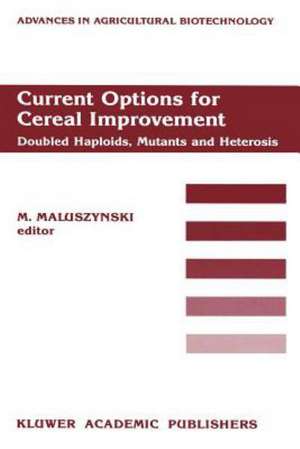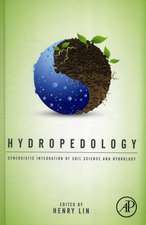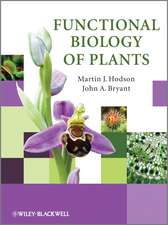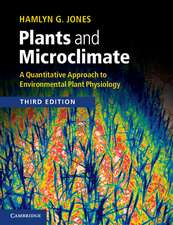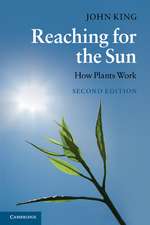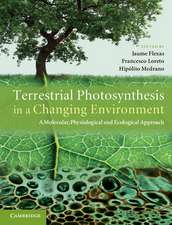Current Options for Cereal Improvement: Doubled Haploids, Mutants and Heterosis Proceedings of the First FAO/IAEA Research Co-ordination Meeting on “Use of Induced Mutations in Connection with Haploids and Heterosis in Cereals”, 8–12 December 1986, Guelph, Canada: Advances in Agricultural Biotechnology, cartea 24
Editat de M. Maluszynskien Limba Engleză Paperback – 20 sep 2011
Din seria Advances in Agricultural Biotechnology
-
 Preț: 386.00 lei
Preț: 386.00 lei - 15%
 Preț: 662.62 lei
Preț: 662.62 lei -
 Preț: 383.33 lei
Preț: 383.33 lei -
 Preț: 381.98 lei
Preț: 381.98 lei - 18%
 Preț: 1381.74 lei
Preț: 1381.74 lei - 18%
 Preț: 1217.41 lei
Preț: 1217.41 lei - 15%
 Preț: 641.38 lei
Preț: 641.38 lei - 18%
 Preț: 949.23 lei
Preț: 949.23 lei - 18%
 Preț: 1231.47 lei
Preț: 1231.47 lei - 18%
 Preț: 1221.20 lei
Preț: 1221.20 lei - 18%
 Preț: 950.21 lei
Preț: 950.21 lei -
 Preț: 402.38 lei
Preț: 402.38 lei -
 Preț: 421.23 lei
Preț: 421.23 lei - 18%
 Preț: 950.33 lei
Preț: 950.33 lei - 18%
 Preț: 1216.48 lei
Preț: 1216.48 lei -
 Preț: 384.31 lei
Preț: 384.31 lei - 18%
 Preț: 1217.41 lei
Preț: 1217.41 lei - 18%
 Preț: 1226.42 lei
Preț: 1226.42 lei -
 Preț: 394.29 lei
Preț: 394.29 lei -
 Preț: 416.26 lei
Preț: 416.26 lei - 18%
 Preț: 953.20 lei
Preț: 953.20 lei -
 Preț: 386.99 lei
Preț: 386.99 lei -
 Preț: 394.87 lei
Preț: 394.87 lei -
 Preț: 392.60 lei
Preț: 392.60 lei
Preț: 384.31 lei
Nou
Puncte Express: 576
Preț estimativ în valută:
73.54€ • 76.97$ • 61.21£
73.54€ • 76.97$ • 61.21£
Carte tipărită la comandă
Livrare economică 31 martie-14 aprilie
Preluare comenzi: 021 569.72.76
Specificații
ISBN-13: 9789401068901
ISBN-10: 9401068909
Pagini: 228
Ilustrații: X, 228 p. 2 illus.
Dimensiuni: 155 x 235 x 12 mm
Greutate: 0.33 kg
Ediția:1989
Editura: SPRINGER NETHERLANDS
Colecția Springer
Seria Advances in Agricultural Biotechnology
Locul publicării:Dordrecht, Netherlands
ISBN-10: 9401068909
Pagini: 228
Ilustrații: X, 228 p. 2 illus.
Dimensiuni: 155 x 235 x 12 mm
Greutate: 0.33 kg
Ediția:1989
Editura: SPRINGER NETHERLANDS
Colecția Springer
Seria Advances in Agricultural Biotechnology
Locul publicării:Dordrecht, Netherlands
Public țintă
ResearchCuprins
Project Reports and Invited Papers.- Quantifying gametoclonal variation in wheat doubled haploids.- Breeding on a cellular level, and research on hybrid F1 development.- Use of high pairing wheat mutants for the transfer of useful traits from alien species into cultivated wheats.- Male sterile facilitated recurrent selection.- Wide hybridization for cereal improvement.- The effect of dwarfing genes on the expression of heterosis for grain yield in F1 hybrid wheat.- A summary on current status of hybrid rice improvement by using induced mutations and in-vitro techniques.- Production of haploids in cereals.- Somaclonal selection of physiological mutants through plant cell culture.- Exploitation and analysis of heterosis in wheat with induced mutations.- Barley mutants — diversity, genetics and plant breeding value.- Barley mutant heterosis.- Rice improvement (involving altered flower structure more suitable to cross-pollination) using in-vitro biotechniques in combination with mutagenesis.- Use of doubled haploid lines in recurrent and natural selection in barley.- Commercialization of the bulbosum method in barley (Hordeum vulgare L.).- Induced mutagenesis to facilitate heterosis and hybrid seed production in barley.- Some prospects of hybrid triticale breeding.- Induction of salt tolerance in high-yielding rice varieties through mutagenesis and anther culture.- Short Communications.- Crossability of spring barley mutants with H. bulbosum.- The commercial application of cereal haploidy..
Recenzii
`... the book contains some papers which will be of interest, mainly to plant breeders and geneticists.'
Plant Growth Regulation 9, 1990
Plant Growth Regulation 9, 1990
